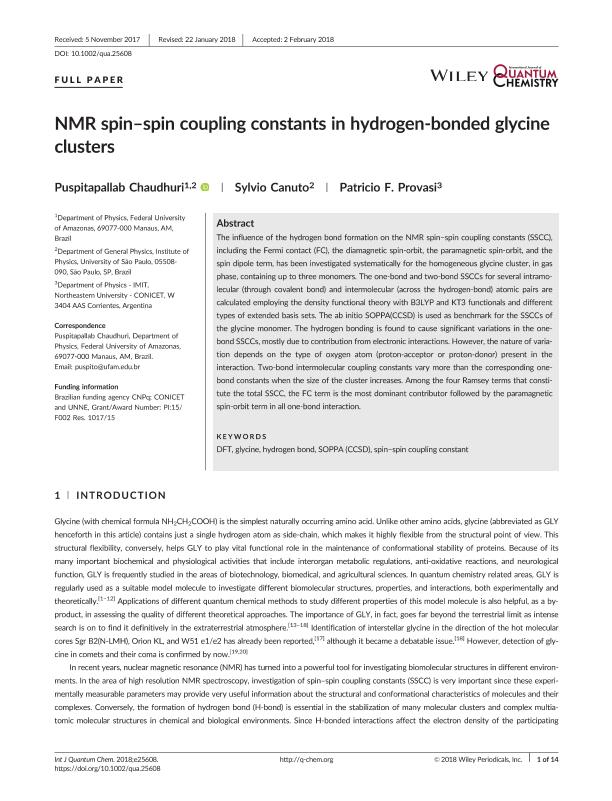Artículo
NMR spin–spin coupling constants in hydrogen-bonded glycine clusters
Fecha de publicación:
08/2018
Editorial:
John Wiley & Sons Inc
Revista:
International Journal of Quantum Chemistry
ISSN:
0020-7608
e-ISSN:
0020-7608
Idioma:
Inglés
Tipo de recurso:
Artículo publicado
Clasificación temática:
Resumen
The influence of the hydrogen bond formation on the NMR spin–spin coupling constants (SSCC), including the Fermi contact (FC), the diamagnetic spin-orbit, the paramagnetic spin-orbit, and the spin dipole term, has been investigated systematically for the homogeneous glycine cluster, in gas phase, containing up to three monomers. The one-bond and two-bond SSCCs for several intramolecular (through covalent bond) and intermolecular (across the hydrogen-bond) atomic pairs are calculated employing the density functional theory with B3LYP and KT3 functionals and different types of extended basis sets. The ab initio SOPPA(CCSD) is used as benchmark for the SSCCs of the glycine monomer. The hydrogen bonding is found to cause significant variations in the one-bond SSCCs, mostly due to contribution from electronic interactions. However, the nature of variation depends on the type of oxygen atom (proton-acceptor or proton-donor) present in the interaction. Two-bond intermolecular coupling constants vary more than the corresponding one-bond constants when the size of the cluster increases. Among the four Ramsey terms that constitute the total SSCC, the FC term is the most dominant contributor followed by the paramagnetic spin-orbit term in all one-bond interaction.
Palabras clave:
DFT
,
GLYCINE
,
HYDROGEN BOND
,
SOPPA (CCSD)
,
SPIN–SPIN COUPLING CONSTANT
Archivos asociados
Licencia
Identificadores
Colecciones
Articulos(IMIT)
Articulos de INST.DE MODELADO E INNOVACION TECNOLOGICA
Articulos de INST.DE MODELADO E INNOVACION TECNOLOGICA
Citación
Chaudhuri, Puspitapallab; Canuto, Sylvio; Provasi, Patricio Federico; NMR spin–spin coupling constants in hydrogen-bonded glycine clusters; John Wiley & Sons Inc; International Journal of Quantum Chemistry; 118; 15; 8-2018; 1-14
Compartir
Altmétricas




